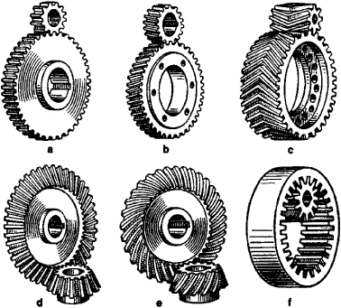Comparison of Belt, Chain and Gear drive
Contents
Difference Between Belt Drive, Chain Drive and Gear Drive with Comparison Chart
Summary:
The major difference between Belt drive and Chain drive is that the Belt drive is one friction drive, and Chain drive is one engagement drive. Both a chain drive and a belt drive allow locomotion and transfer the power within a particular piece of machinery. Chain drives and Belt drives used in bicycles, motorcycles, and automobiles.

Comparison Chart
| Belt drive | Chain drive | Gear drive |
|---|---|---|
| Main element Pulleys, belt | Main element Sprockets, chain | Main element Gears |
| Slip may occur | No-slip | No-slip |
| Suitability For the large center distance |
Suitability For the moderate center distance |
Suitability For the short center distance |
| Large Space requires | Moderate Space requires | Less Space requires |
| Simplest Design, manufacturing, complexity |
Simplest Design, manufacturing, complexity |
Complicated Design, manufacturing, complexity |
| Failure of the belt does not cause the further damage of machine |
Failure of a chain may not seriously damage the machine. |
Failure of gear may cause serious break down in the machine. |
| Less Life | Moderate Life | Long Life |
| Lubrication Not required | Lubrication required | Requires proper lubrication |
| Less Installation cost | Moderate Installation cost | More Installation cost |
| Used For low-velocity ratio | Used For moderate velocity ratio |
Used For high velocity ratio |
Chain Drive
Slipping occurs in belt and rope drives. In order to avoid these slipping phenomenon chain drives are used. A
chain drive consists of three elements
- Driving sprocket
- Driven sprocket
- An endless chain which is wrapped around two sprockets

Advantages of Chain Drive
- It provides a positive transmission and no chances of slip are there.
- It gives a constant velocity ratio
Applications of Chain Drive
- It is used in bicycle, motorcycles, agricultural machinery and textile machinery, material handling equipment
etc.
Types of Chain
- Hoisting and Hauling chains
- Conveyor chains
- Power transmission chains
Gear Drive
- A gear is a rotating machine part having cut teeth, or cogs, which mesh with another toothed part in order to
transmit torque and power. - In order to transmit a definite power from one shaft to another shaft to the projection on one disc and recesses
on another disc can be made which can mesh with each other. - In the early days, friction discs as shown in the figure were used for transmitting the power from one shaft to another shaft. In such a case, the power transmission capacity depends on the friction between surfaces of two discs. Therefore, this method is not suitable for transmitting higher power as a slip occurs between the discs.

Advantages of Gear drive
- It is a positive drive (no slip) i.e. it transmits exact velocity ratio from one shaft to another shaft.
- It can transmit very large power.
- High transmission efficiency.
- It requires less space.
- This drive is more reliable.
Disadvantages of Gear drive
- Manufacturing cost is high.
- Maintenance cost is also high due to lubrication requirements.
- The error in cutting teeth may cause vibrations and noise during operation.It requires precise alignment of shafts.
Types of gears
- Spur gear
- Helical gear
- Rack and Pinion gear
- Bevel gear
- Worm and worm wheel
- Spiral gear
More Differences
- Difference Between Vapour Compression and Vapour Absorption System
- Difference Between Individual Drive and Group Drive
